Numerical Investigation for the Impact of Single Groove on the Stall Margin Improvement and the Unsteadiness of Tip Leakage Flow in a Counter-Rotating Axial Flow Compressor
Abstract
1. Introduction
2. Compressor Geometry and CT Design
3. Numerical Method and Validation
4. Results and Discussion
4.1. Effects of CTs on the SMI
4.2. The Impact of CTs on the Inside Unsteady Fluctuations
5. Conclusions
- Parametric studies on the axial location illustrate that the best location (G2) for a single groove of the CRAC should be at about 20% Ca in terms of the SMI (about 4.0%). The interfaces between the TLF and incoming main flow are pushed downstream to different extents by the CTs.
- The locations of the effective CTs are coincident with the range of the high fluctuating region on the blade pressure surface in the SW case and the best scheme of G2 is just located at the position of peak fluctuation. Therefore, the unsteadiness of TLF plays an important role in the stall inception process.
- Both two low frequency components of 0.31 BPF and 0.47 BPF in the SW case are suppressed in the two CTs. The oscillating frequency of the unsteady TLF is changed from 0.74 BPF to 0.82 BPF in G2. Additionally, the amplitudes of the fluctuations on the pressure side are also decreased obviously. Therefore, the vanishing of the low frequency components and the suppression of the TLF unsteadiness are both beneficial to the SMI.
- It is more effective to improve the flow stability by controlling the critical TLF released from near the mid-chord, while the improvement of main TLF released near the blade leading edge is not necessary to achieve the effectiveness of SMI.
Acknowledgments
Author Contributions
Conflicts of Interest
Nomenclature
| Ca | Axial chord of blade tip |
| Crtp | Relative total pressure coefficient |
| d | Groove depth |
| Local static pressure | |
| Local relative total pressure | |
| Inlet total pressure | |
| U | Rotor tip speed |
| w | Groove width |
| Nondimensional wall distance | |
| Density | |
| Total pressure ratio | |
| Change of stall margin | |
| Nondimensional mass flow rate | |
| Absolute vorticity |
Abbreviations
| 3D | Three dimensional |
| BPF | Blade passing frequency |
| CRAC | Counter-rotating axial flow compressor |
| CT | Casing treatment |
| FFT | Fast Fourier transformation |
| IGV | Inlet guide vane |
| LE | Leading edge |
| OGV | Outlet guide vane |
| PS | Pressure surface |
| R1 | Clockwise rotating rotor |
| R2 | Anti-clockwise rotating rotor |
| SMI | Stall margin improvement |
| SS | Suction surface |
| STD | Standard deviation |
| SW | Smooth wall |
| TE | Trailing edge |
| TLF | Tip leakage flow |
References
- Vo, H.D. Rotating stall suppression in axial compressors with casing plasma actuation. J. Propuls. Power 2010, 26, 808–818. [Google Scholar] [CrossRef]
- Choi, M.; Vahdati, M. Recovery process from rotating stall in a fan. J. Propuls. Power 2011, 27, 1161–1168. [Google Scholar] [CrossRef]
- Furukawa, M.; Saiki, K.; Yamada, K.; Inoue, M. Unsteady flow behavior due to breakdown of tip leakage vortex in an axial compressor rotor at near-stall condition. In Proceedings of the ASME Turbo Expo 2000: Power for Land, Sea, and Air, Munich, Germany, 8–11 May 2000. [Google Scholar]
- Maerz, J.; Hah, C.; Neise, W. Discussion of an experimental and numerical investigation into the mechanisms of rotating instability. J. Turbomach. 2002, 124, 375. [Google Scholar] [CrossRef]
- Yamada, K.; Furukawa, M.; Nakano, T.; Inoue, M.; Funazaki, K. Unsteady three-dimensional flow phenomena due to breakdown of tip leakage vortex in a transonic axial compressor rotor. In Proceedings of the ASME Turbo Expo 2004: Power for Land, Sea, and Air, Vienna, Austria, 14–17 June 2004. [Google Scholar]
- Du, J.; Lin, F.; Zhang, H.; Chen, J. Numerical investigation on the self-induced unsteadiness in tip leakage flow for a transonic fan rotor. J. Turbomach. 2010, 132, 021017. [Google Scholar] [CrossRef]
- Sakulkaew, S.; Tan, C.S.; Donahoo, E.; Cornelius, C.; Montgomery, M. Compressor efficiency variation with rotor tip gap from vanishing to large clearance. J. Turbomach. 2013, 135, 031030. [Google Scholar] [CrossRef]
- Cameron, J.D.; Bennington, M.A.; Ross, M.H.; Morris, S.C.; Du, J.; Lin, F.; Chen, J. The Influence of Tip Clearance Momentum Flux on Stall Inception in a High-Speed Axial Compressor. J. Turbomach. 2013, 135, 051005. [Google Scholar] [CrossRef]
- Du, J.; Lin, F.; Chen, J.; Nie, C.; Biela, C. Flow structures in the tip region for a transonic compressor rotor. J. Turbomach. 2013, 135, 031012. [Google Scholar] [CrossRef]
- Yamada, K.; Kikuta, H.; Iwakiri, K.; Furukawa, M.; Gunjishima, S. An explanation for flow features of spike-type stall inception in an axial compressor rotor. J. Turbomach. 2013, 135, 021023. [Google Scholar] [CrossRef]
- Pullan, G.; Young, A.M.; Day, I.J.; Greitzer, E.M.; Spakovszky, Z.S. Origins and structure of spike-type rotating stall. J. Turbomach. 2015, 137, 051007. [Google Scholar] [CrossRef]
- Day, I.J. Stall, surge, and 75 years of research. J. Turbomach. 2016, 138, 011001. [Google Scholar] [CrossRef]
- Jothiprasad, G.; Murray, R.C.; Essenhigh, K.; Bennett, G.A.; Saddoughi, S.; Wadia, A.; Breeze-Stringfellow, A. Control of tip-clearance flow in a low speed axial compressor rotor with plasma actuation. J. Turbomach. 2012, 134, 021019. [Google Scholar] [CrossRef]
- Bae, J.W.; Breuer, K.S.; Tan, C.S. Active control of tip clearance flow in axial compressors. J. Turbomach. 2005, 127, 352–362. [Google Scholar] [CrossRef]
- Gümmer, V.; Goller, M.; Swoboda, M. Numerical investigation of end wall boundary layer removal on highly loaded axial compressor blade rows. J. Turbomach. 2008, 130, 011015. [Google Scholar] [CrossRef]
- Jung, Y.J.; Jeon, H.; Jung, Y.; Lee, K.J.; Choi, M. Effects of recessed blade tips on stall margin in a transonic axial compressor. Aerosp. Sci. Technol. 2016, 54, 41–48. [Google Scholar] [CrossRef]
- Han, S.; Zhong, J. Effect of blade tip winglet on the performance of a highly loaded transonic compressor rotor. Chin. J. Aeronaut. 2016, 29, 653–661. [Google Scholar] [CrossRef]
- Zhao, S.; Lu, X.; Zhu, J.; Zhang, H. Investigation for the effects of circumferential grooves on the unsteadiness of tip clearance flow to enhance compressor flow instability. In Proceedings of the ASME Turbo Expo 2010: Power for Land, Sea, and Air, Glasgow, UK, 14–18 June 2010. [Google Scholar]
- Hwang, Y.; Kang, S.H. Numerical study on the effects of casing treatment on unsteadiness of tip leakage flow in an axial compressor. In Proceedings of the ASME Turbo Expo 2012: Turbine Technical Conference and Exposition, Copenhagen, Denmark, 11–15 June 2012. [Google Scholar]
- Du, J.; Li, J.; Wang, K.; Lin, F.; Nie, C. The Self-induced unsteadiness of tip leakage flow in an axial low-speed compressor with single circumferential casing groove. J. Therm. Sci. 2013, 22, 565–572. [Google Scholar] [CrossRef]
- Taghavi-Zenouz, R.; Abbasi, S. Alleviation of spike stall in axial compressors utilizing grooved casing treatment. Chin. J. Aeronaut. 2015, 28, 649–658. [Google Scholar] [CrossRef]
- Juan, D.; Jichao, L.; Lipeng, G.; Feng, L.; Jingyi, C. The impact of casing groove location on stall margin and tip Clearance flow in a low-speed axial compressor. J. Turbomach. 2016, 138, 121007. [Google Scholar] [CrossRef]
- Liu, L.; Li, J.; Nan, X.; Lin, F. The stall inceptions in an axial compressor with single circumferential groove casing treatment at different axial locations. Aerosp. Sci. Technol. 2016, 59, 145–154. [Google Scholar] [CrossRef]
- Alone, D.B.; Kumar, S.S.; Shobhavathy, M.T.; Mudipalli, J.R.R.; Pradeep, A.M.; Ramamurthy, S.; Iyengar, V.S. Experimental assessment on effect of lower porosities of bend skewed casing treatment on the performance of high speed compressor stage with tip critical rotor characteristics. Aerosp. Sci. Technol. 2017, 60, 193–202. [Google Scholar] [CrossRef]
- Sun, D.; Liu, X.; Sun, X. An evaluation approach for the stall margin enhancement with stall precursor-suppressed casing treatment. J. Fluids Eng. 2015, 137, 081102. [Google Scholar] [CrossRef]
- Dong, X.; Sun, D.; Li, F.; Jin, D.; Gui, X.; Sun, X. Effects of rotating inlet distortion on compressor stability with stall precursor-suppressed casing treatment. J. Fluids Eng. 2015, 137, 111101. [Google Scholar] [CrossRef]
- Sun, D.; Nie, C.; Liu, X.; Lin, F.; Sun, X. Further investigation on transonic compressor stall margin enhancement with stall precursor-suppressed casing treatment. J. Turbomach. 2016, 138, 021001. [Google Scholar] [CrossRef]
- Schimming, P. Counter rotating fans—An aircraft propulsion for the future? J. Therm. Sci. 2003, 12, 97–103. [Google Scholar] [CrossRef]
- Joly, M.; Verstraete, T.; Paniagua, G. Full design of a highly loaded and compact contra-rotating fan using multidisciplinary evolutionary optimization. In Proceedings of the ASME Turbo Expo 2013: Turbine Technical Conference and Exposition, San Antonio, TX, USA, 3–7 June 2013. [Google Scholar]
- Sharma, P.B.; Jain, Y.P.; Pundhir, D.S. A study of some factors affecting the performance of a contra-rotating axial compressor stage. Proc. Inst. Mech. Eng. Part A 1988, 202, 15–21. [Google Scholar] [CrossRef]
- Kerrebrock, J.L.; Epstein, A.H.; Merchant, A.A.; Guenette, G.R.; Parker, D.; Onnee, J.F.; Neumayer, F.; Adamczyk, J.J.; Shabbir, A. Design and test of an aspirated counter-rotating fan. J. Turbomach. 2008, 130, 021004. [Google Scholar] [CrossRef]
- Nouri, H.; Danlos, A.; Ravelet, F.; Bakir, F.; Sarraf, C. Experimental study of the instationary flow between two ducted counter-rotating rotors. J. Eng. Gas Turbines Power 2013, 135, 022601. [Google Scholar] [CrossRef]
- Mistry, C.; Pradeep, A.M. Influence of circumferential inflow distortion on the performance of a low speed, high aspect ratio contra rotating axial fan. J. Turbomach. 2014, 136, 071009. [Google Scholar] [CrossRef]
- Shi, L.; Liu, B.; Na, Z.; Wu, X.; Lu, X. Experimental investigation of a counter-rotating compressor with boundary layer suction. Chin. J. Aeronaut. 2015, 28, 1044–1054. [Google Scholar] [CrossRef]
- Gao, L.; Li, R.; Miao, F.; Cai, Y. Unsteady investigation on tip flow field and rotating stall in counter-rotating axial compressor. J. Eng. Gas Turbines Power 2015, 137, 072603. [Google Scholar] [CrossRef]
- Wang, Y.; Chen, W.; Wu, C.; Ren, S. Effects of tip clearance size on the performance and tip leakage vortex in dual-rows counter-rotating compressor. Proc. Inst. Mech. Eng. Part G 2015, 229, 1953–1965. [Google Scholar] [CrossRef]
- Mao, X.; Liu, B. Numerical investigation of the unsteady flow behaviors in a counter-rotating axial compressor. Proc. Inst. Mech. Eng. Part A 2016, 230, 289–301. [Google Scholar] [CrossRef]
- Mao, X.; Liu, B. Numerical study of the unsteady behaviors and rotating stall inception process in a counter-rotating axial compressor. Proc. Inst. Mech. Eng. Part G 2016, 230, 2716–2727. [Google Scholar] [CrossRef]
- Pundhir, D.S.; Sharma, P.B.; Chaudhary, K.K. Effect of casing treatment on aerodynamic performance of a contrarotating axial compressor stage. Proc. Inst. Mech. Eng. Part A 1990, 204, 47–55. [Google Scholar] [CrossRef]
- IGG v8.7, User Manual; NUMECA International: Brussels, Belgium, 2009.
- FINE/Turbo v8.7, User Manual; NUMECA International: Brussels, Belgium, 2009.
- Spalart, P.R.; Allmaras, S.R. A one-equation turbulence model for aerodynamic flows. In Proceedings of the 30th Aerospace Sciences Meeting and Exhibit, Reno, NV, USA, 6–9 January 1992. [Google Scholar]
- Gao, L.; Li, X.; Feng, X.; Liu, B. The effect of tip clearance on the performance of contra-rotating compressor. In Proceedings of the ASME Turbo Expo 2012: Turbine Technical Conference and Exposition, Copenhagen, Denmark, 11–15 June 2012. [Google Scholar]
- AutoGrid5 v8.7, User Manual; NUMECA International: Brussels, Belgium, 2009.
- Vo, H.D. Role of Tip Clearance Flow on Axial Compressor; Massachusetts Institute of Technology: Cambridge, MA, USA, 2002. [Google Scholar]
- Tong, Z.; Lin, F.; Chen, J.; Nie, C.Q. The self-induced unsteadiness of tip leakage vortex and its effect on compressor stall inception. In Proceedings of the ASME Turbo Expo 2007: Power for Land, Sea, and Air, Montreal, QC, Canada, 14–17 May 2007. [Google Scholar]
- Gourdain, N.; Burguburu, S.; Leboeuf, F.; Miton, H. Numerical simulation of rotating stall in a subsonic compressor. Aerosp. Sci. Technol. 2006, 10, 9–18. [Google Scholar] [CrossRef]
- Gourdain, N.; Burguburu, S.; Leboeuf, F.; Michon, G.J. Simulation of rotating stall in a whole stage of an axial compressor. Comput. Fluids 2010, 39, 1644–1655. [Google Scholar] [CrossRef]
- Shabbir, A.; Adamczyk, J.J. Flow mechanism for stall margin improvement due to circumferential casing grooves on axial compressors. J. Turbomach. 2005, 127, 708–717. [Google Scholar] [CrossRef]
- Chen, H.; Huang, X.; Shi, K.; Fu, S.; Ross, M.; Bennington, M.A.; Cameron, J.D.; Morris, S.C.; McNulty, S.; Wadia, A. A computational fluid dynamics study of circumferential groove casing treatment in a transonic axial compressor. J. Turbomach. 2014, 136, 031003. [Google Scholar] [CrossRef]

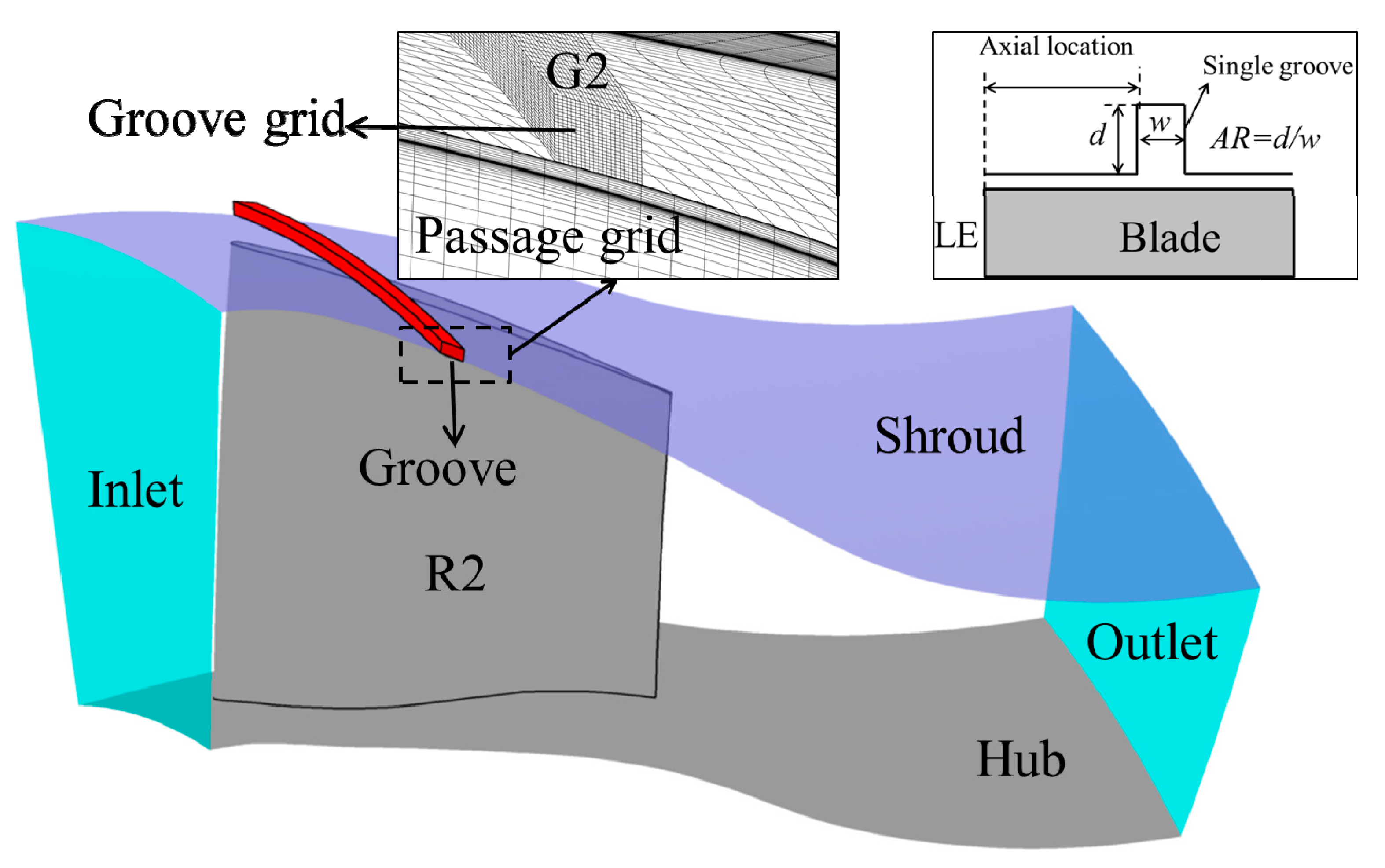
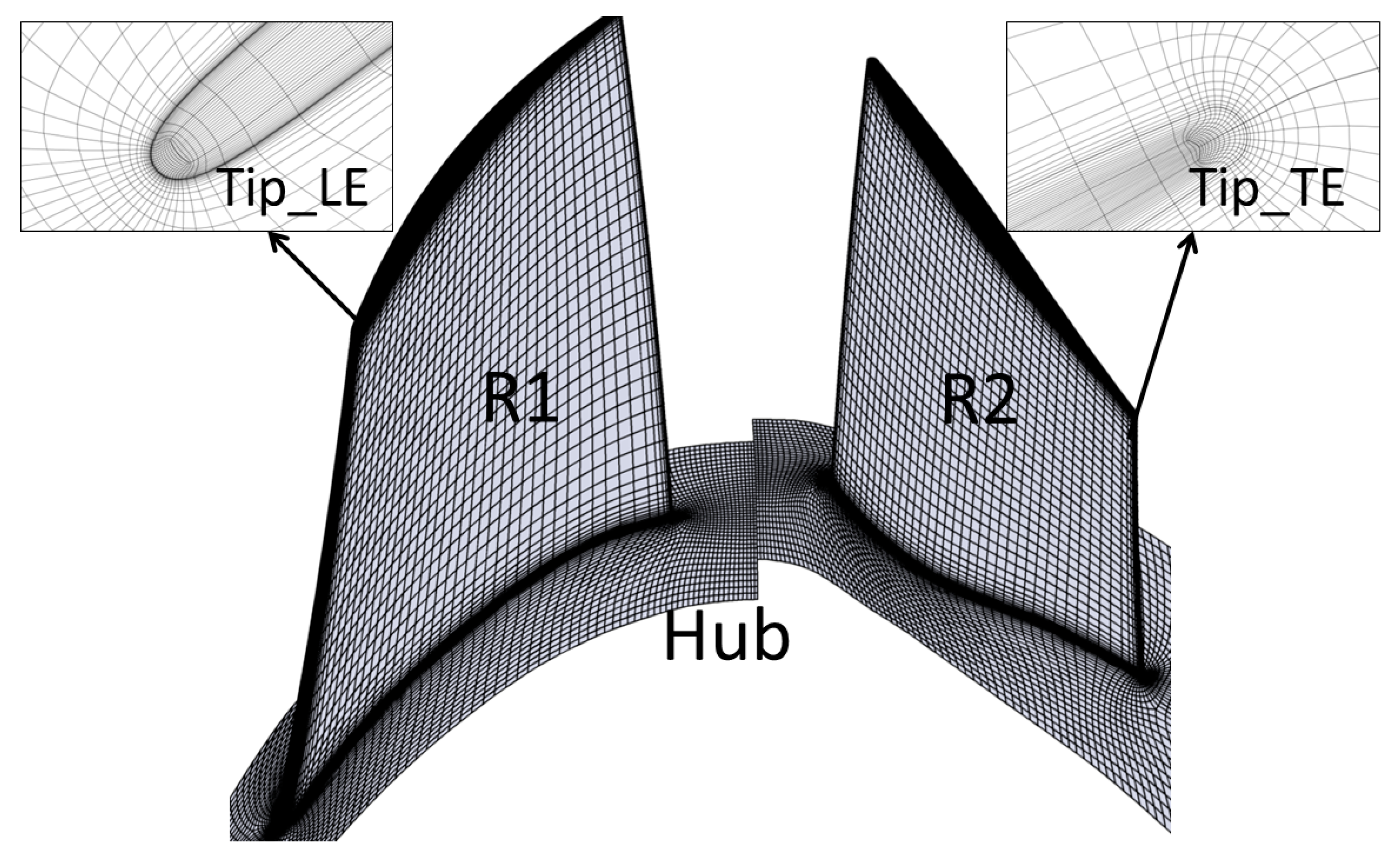
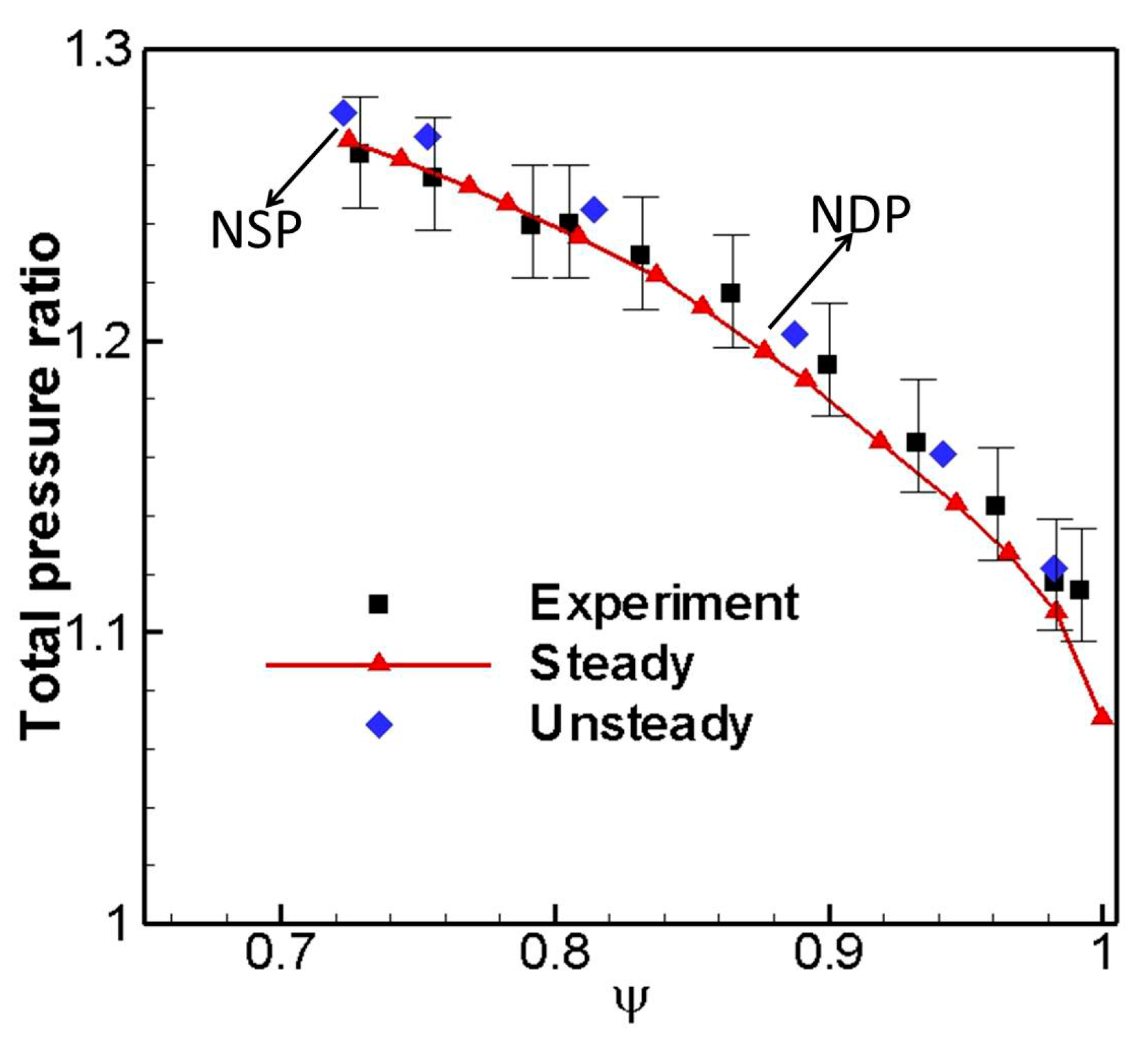

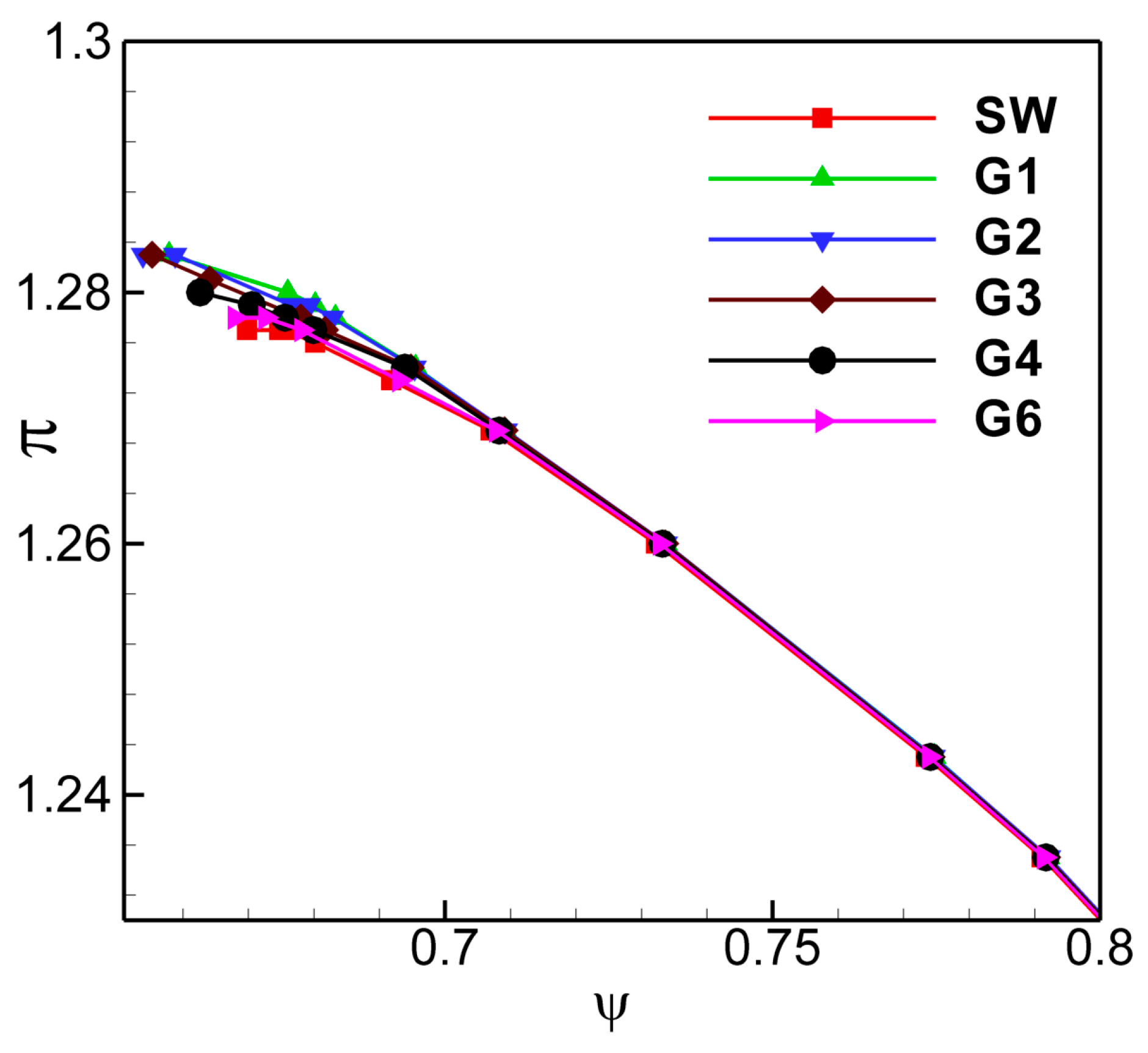
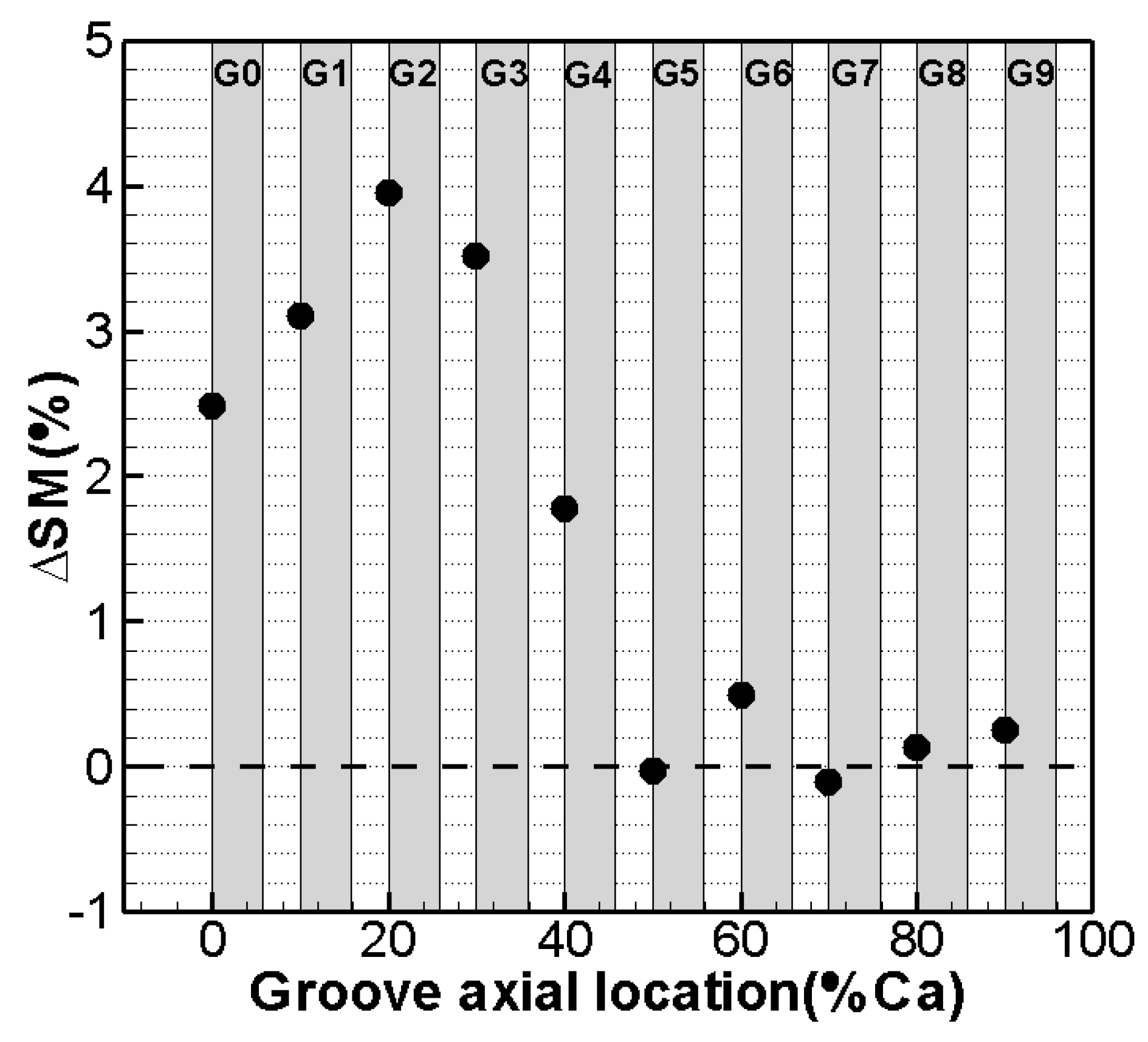
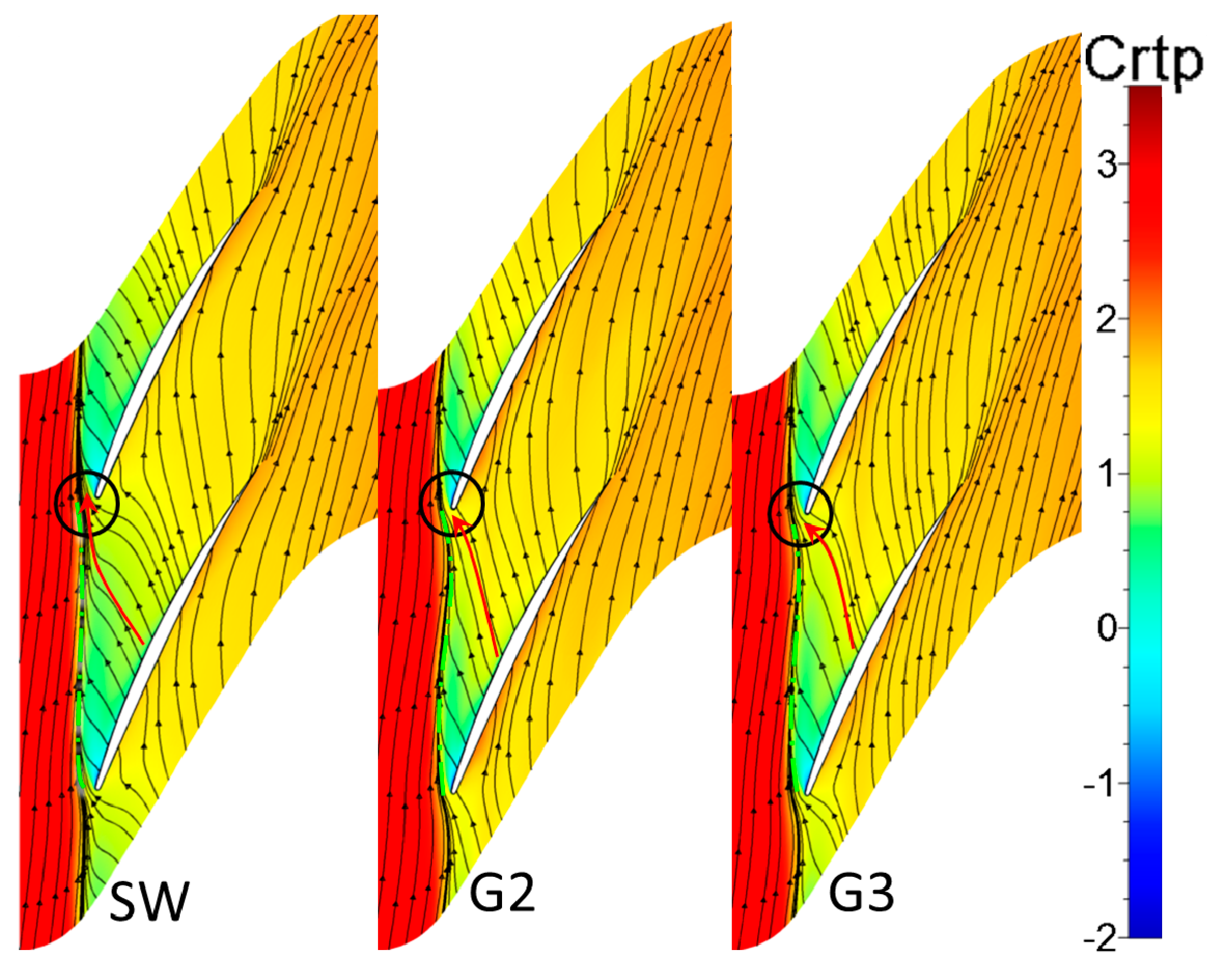
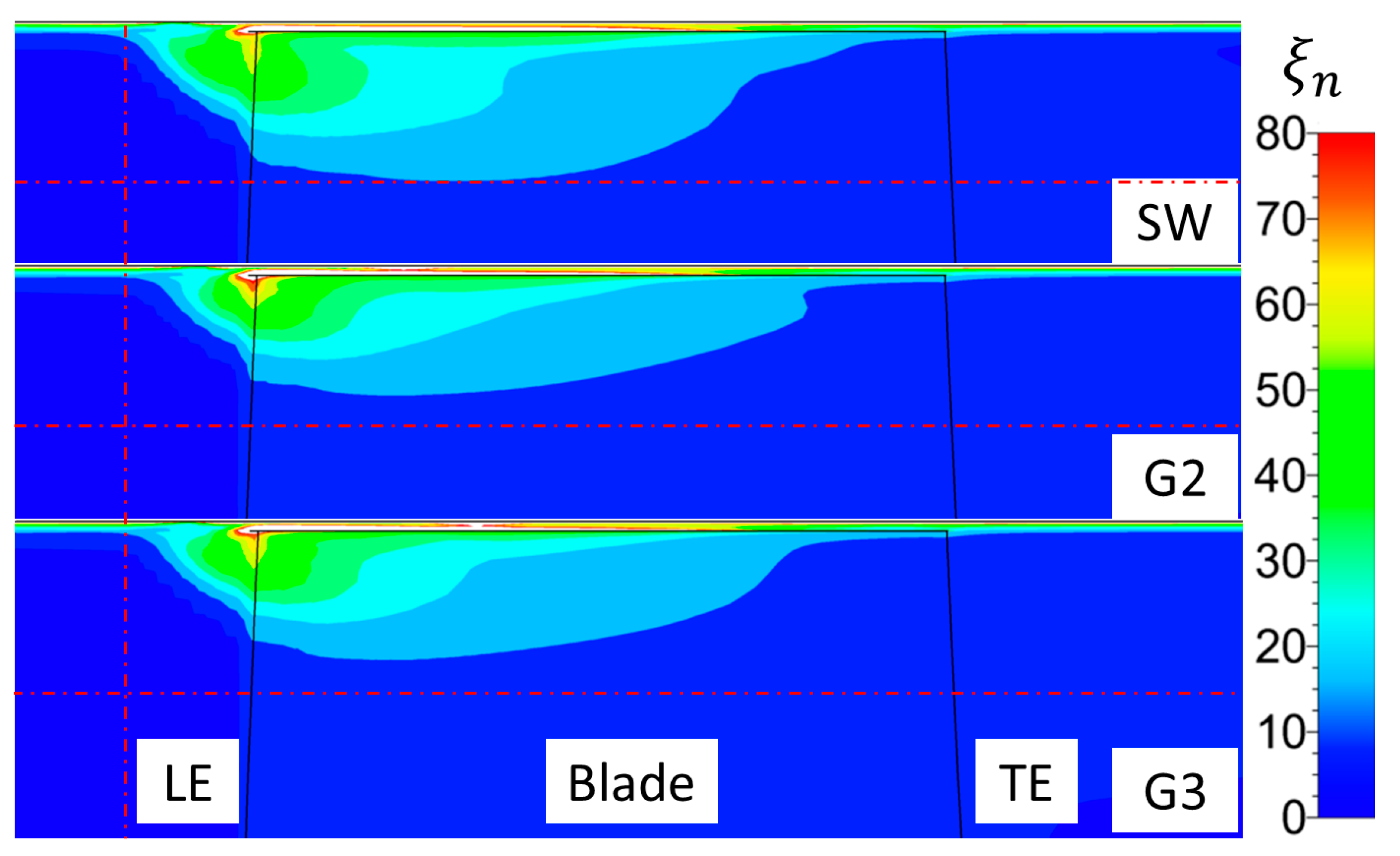



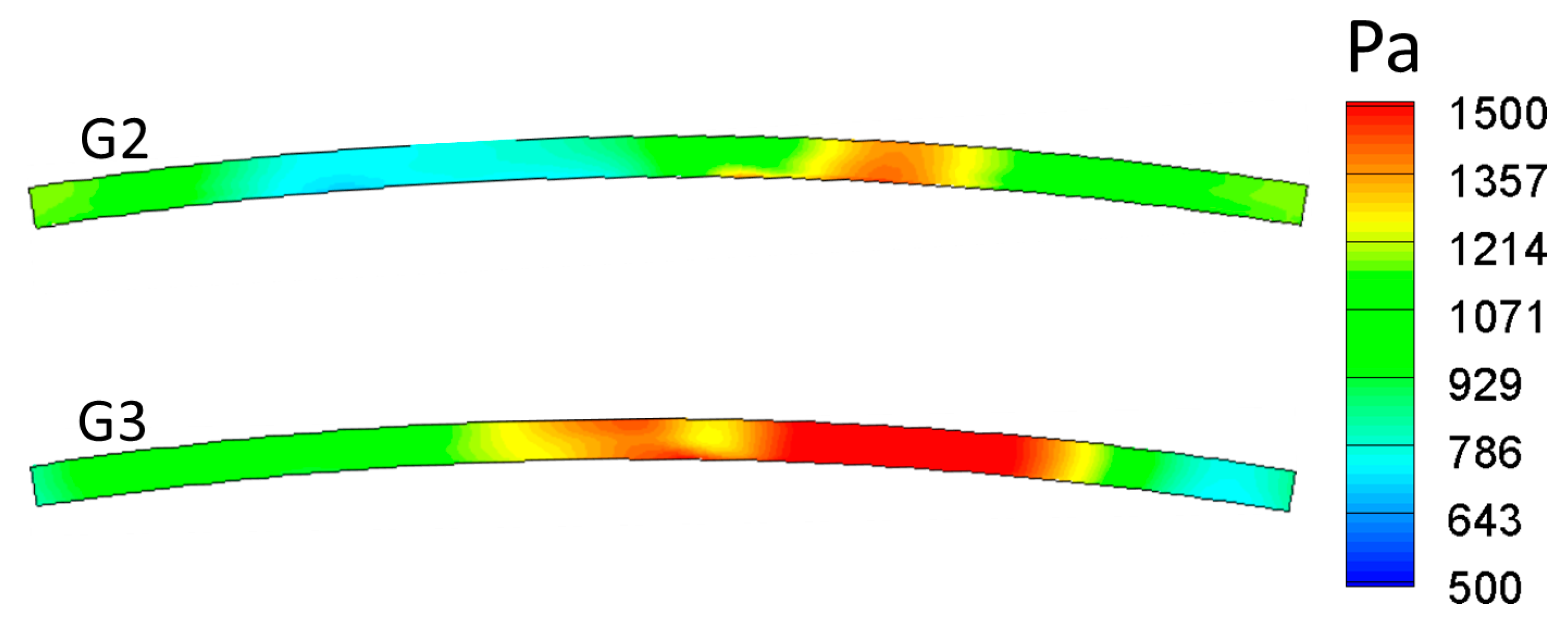

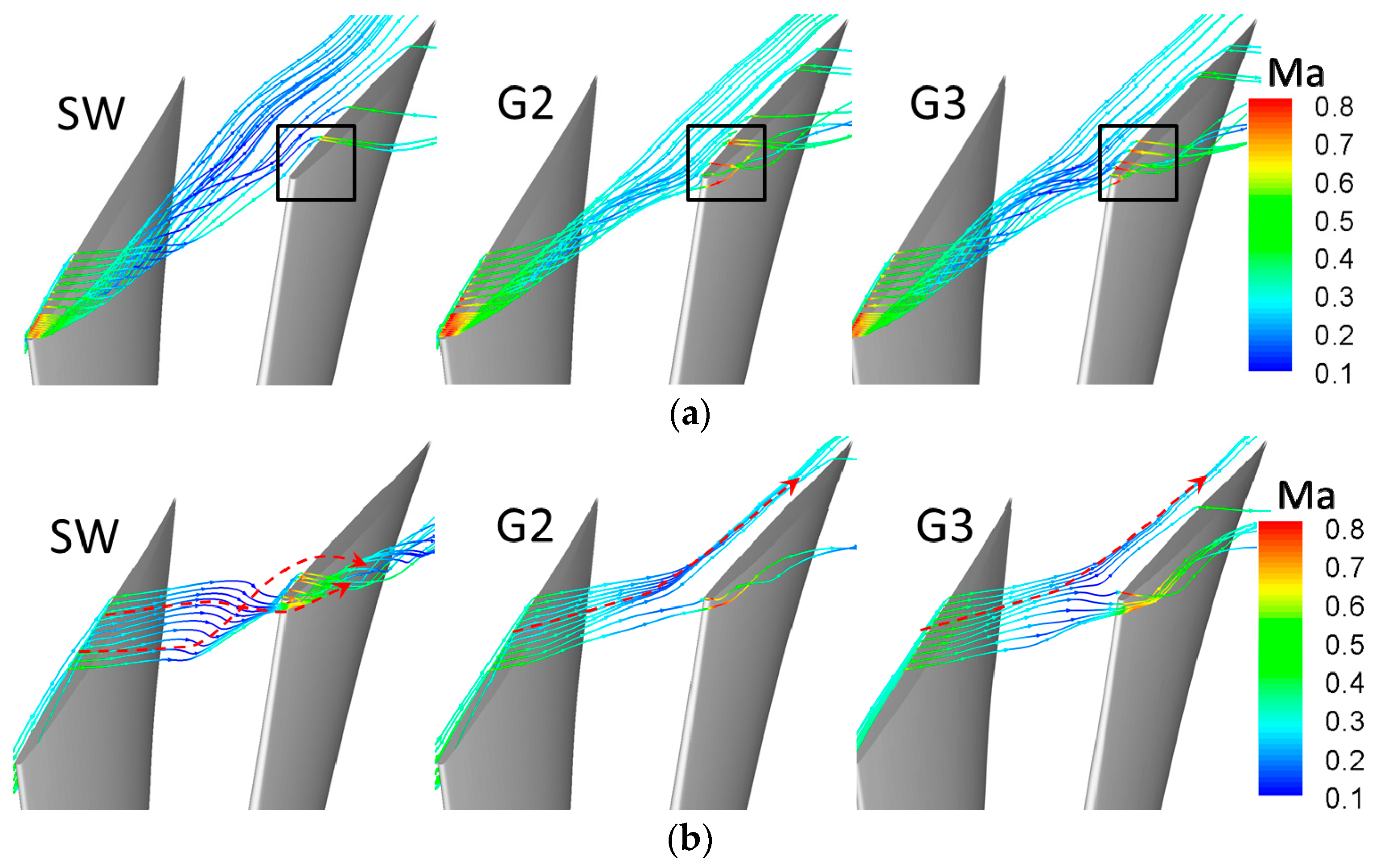
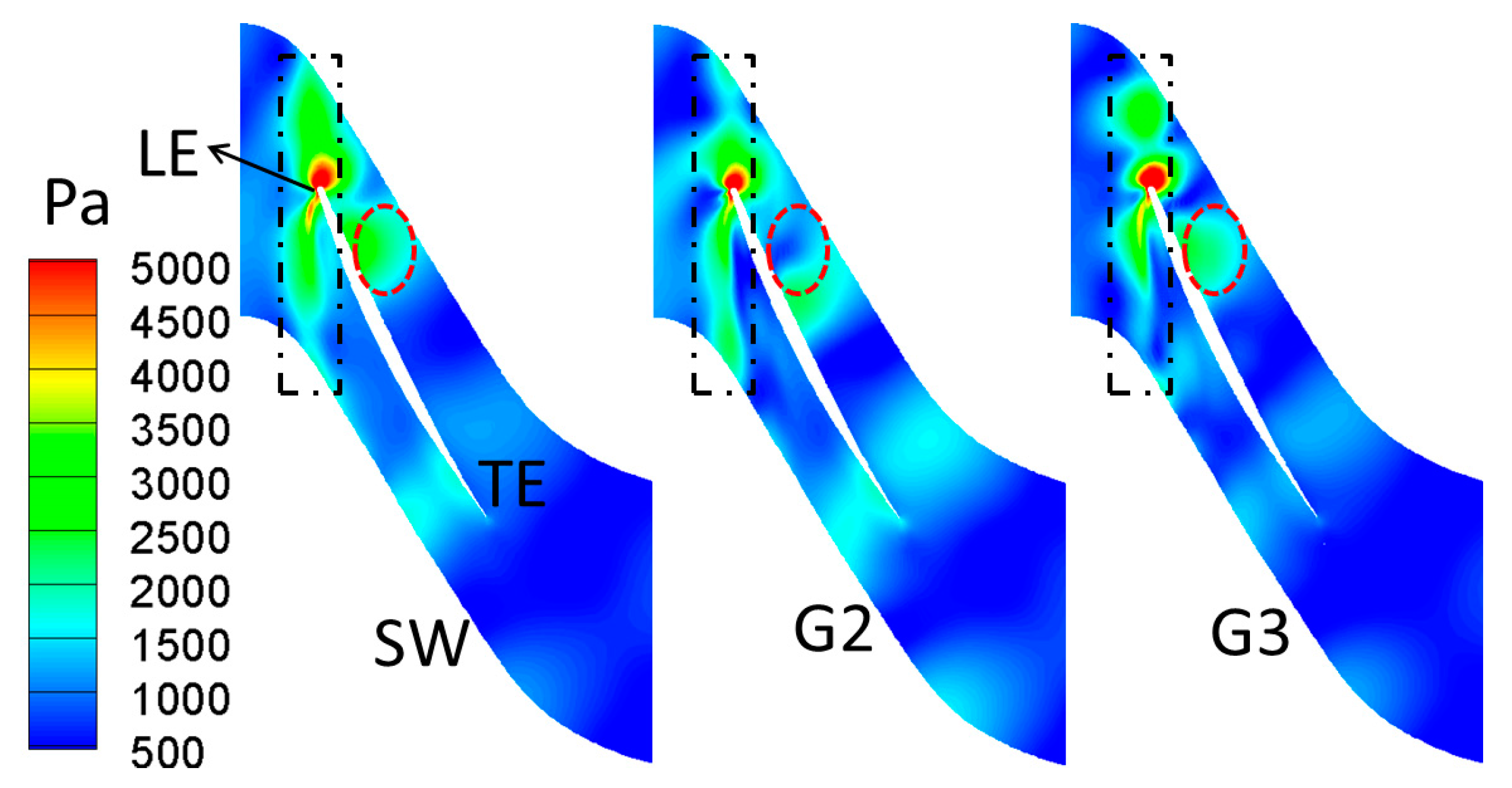
| Design Parameter | R1 | R2 |
|---|---|---|
| Blade number | 19 | 20 |
| Tip clearance (mm) | 0.5 | 0.5 |
| Hub-tip ratio | 0.485 | 0.641 |
| Rotational speed (rpm) | 8000 | −8000 |
| Tip blade chord (m) | 0.0832 | 0.0769 |
| Tip speed (m/s) | 167.6 | 167.6 |
© 2017 by the authors. Licensee MDPI, Basel, Switzerland. This article is an open access article distributed under the terms and conditions of the Creative Commons Attribution (CC BY) license (http://creativecommons.org/licenses/by/4.0/).
Share and Cite
Mao, X.; Liu, B.; Zhao, H. Numerical Investigation for the Impact of Single Groove on the Stall Margin Improvement and the Unsteadiness of Tip Leakage Flow in a Counter-Rotating Axial Flow Compressor. Energies 2017, 10, 1153. https://doi.org/10.3390/en10081153
Mao X, Liu B, Zhao H. Numerical Investigation for the Impact of Single Groove on the Stall Margin Improvement and the Unsteadiness of Tip Leakage Flow in a Counter-Rotating Axial Flow Compressor. Energies. 2017; 10(8):1153. https://doi.org/10.3390/en10081153
Chicago/Turabian StyleMao, Xiaochen, Bo Liu, and Hang Zhao. 2017. "Numerical Investigation for the Impact of Single Groove on the Stall Margin Improvement and the Unsteadiness of Tip Leakage Flow in a Counter-Rotating Axial Flow Compressor" Energies 10, no. 8: 1153. https://doi.org/10.3390/en10081153
APA StyleMao, X., Liu, B., & Zhao, H. (2017). Numerical Investigation for the Impact of Single Groove on the Stall Margin Improvement and the Unsteadiness of Tip Leakage Flow in a Counter-Rotating Axial Flow Compressor. Energies, 10(8), 1153. https://doi.org/10.3390/en10081153




